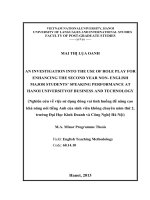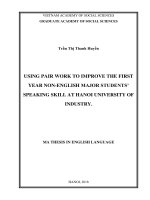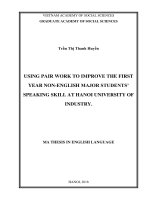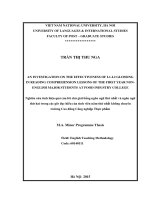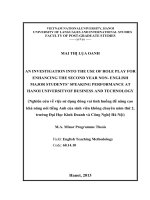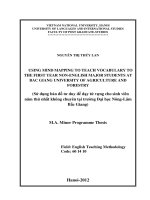Using pair work to improve the first year non english major students’ speaking skill at hanoi university of industry
Bạn đang xem bản rút gọn của tài liệu. Xem và tải ngay bản đầy đủ của tài liệu tại đây (977.76 KB, 86 trang )
VIETNAM ACADEMY OF SOCIAL SCIENCES
GRADUATE ACADEMY OF SOCIAL SCIENCES
Trần Thị Thanh Huyền
USING PAIR WORK TO IMPROVE THE FIRST
YEAR NON-ENGLISH MAJOR STUDENTS’
SPEAKING SKILL AT HANOI UNIVERSITY OF
INDUSTRY.
MA THESIS IN ENGLISH LANGUAGE
HANOI, 2018
VIETNAM ACADEMY OF SOCIAL SCIENCES
GRADUATE ACADEMY OF SOCIAL SCIENCES
Trần Thị Thanh Huyền
USING PAIR WORK TO IMPROVE THE FIRST
YEAR NON-ENGLISH MAJOR STUDENTS’
SPEAKING SKILL AT HANOI UNIVERSITY OF
INDUSTRY.
Field: English Language
Code: 8220201
Supervisor: Assoc. Prof. Dr. Phan Văn Quế
HANOI, 2018
DECLARATION BY AUTHOR
I declare that this thesis, entitled “Using Pair Work to Improve the First
Year Non English Major Students’ Speaking Skill at Hanoi University of
Industry”. This study has been composed solely by myself and has not been
submitted for any other degree or professional qualification. Except where states
otherwise by reference or acknowledgment, the work presented is entirely my
own.
Author’s Signature
Trần Thị Thanh Huyền
Approved by
SUPERVISOR
Assoc. Prof. Dr. Phan Văn Quế
Date:……………………
i
ACKNOWLEDGEMENTS
I would first like to express my sincere thanks to my supervisor Associate
Professor Doctor Phan Văn Quế for his useful comments, remarks and
recommendation through the process of completing this master thesis.
Furthermore, I would like to thank Dr Đặng Nguyên Giang
for
introducing me to the topic as well for the support on the way. Also, I would like
to thank all of the lecturers at Graduate Academy of Social Sciences for their
useful and interesting lessons that have helped to increase my interest in English
language and teaching.
In addition, my sincere gratitude goes to the teachers and students of
Hanoi University of Industry, who have willingly spent their precious time
during the process of interviewing.
Finally, I would like to thank my beloved family and friends, who have
supported me throughout entire study, both by keeping me harmonious and
helping me putting pieces together. I will be grateful forever for your love.
ii
TABLE OF CONTENTS
DECLARATION BY AUTHOR .....................................................................................i
ACKNOWLEDGEMENTS ........................................................................................... ii
TABLE OF CONTENTS .............................................................................................. iii
ABSTRACT ....................................................................................................................v
LIST OF TABLES .........................................................................................................vi
LIST OF FIGURES ...................................................................................................... vii
LIST OF ABBREVIATIONS USED IN THE THESIS ............................................. viii
CHAPTER 1: INTRODUCTION ................................................................................1
1.1. Rationale...............................................................................................................1
1.2. Aims of the Study.................................................................................................2
1.3. Research Questions .............................................................................................. 2
1.4. Scope of the Study ............................................................................................... 3
1.5. Significance of the Study .....................................................................................3
1.6. Research Methods ................................................................................................ 3
1.7. Structure of the Study...........................................................................................3
CHAPTER 2: LITERATURE REVIEW ....................................................................4
2.1. Communicative Language Teaching Approach ...................................................4
2.1.1. Definitions of CLT ........................................................................................4
2.1.2. Characteristics of CLT ..................................................................................5
2.2. Speaking Skill ......................................................................................................7
2.2.1. Definitions of Speaking ................................................................................7
2.2.2. The Importance of Speaking Skill ................................................................ 9
2.2.3. Types of Speaking Performance .................................................................10
2.2.4. Principles for Teaching Speaking Skill ......................................................11
2.3 Pair Work ............................................................................................................13
2.3.1. Definition of Pair Work ..............................................................................13
2.3.2. Procedures of Pair Work .............................................................................14
2.3.3. Some Common Activities for Pair Work....................................................14
2.3.4. Advantages of Using Pair Work in Teaching Speaking Skill.....................16
2.3.5. Disadvantages of Using Pair Work in Teaching Speaking Skill ................18
2.4. Previous Research related to Pair Work............................................................. 19
2.5. Chapter Summary............................................................................................... 22
CHAPTER 3: METHODOLOGY .............................................................................24
3.1. Research Design .................................................................................................24
3.1.1. Definitions of Action Research...................................................................24
3.1.2. Procedures of Action research ....................................................................26
iii
3.2. The Context of the Study ...................................................................................30
3.3. Participants .........................................................................................................31
3.3.1. The Researcher............................................................................................ 31
3.3.2. The Teachers ............................................................................................... 31
3.3.3. The Students................................................................................................ 32
3.4. Procedures of the Study .....................................................................................32
3.4.1. Diagnosing ..................................................................................................33
3.4.2. Planning ......................................................................................................34
3.4.3. Acting and Observing .................................................................................34
3.4.4. Reflecting ....................................................................................................35
3.5. Data Collection Instruments ...............................................................................35
3.5.1. Survey Questionnaire for Teachers and Students ......................................35
3.5.2. English Speaking Test ................................................................................38
3.5.3. Class Observation Form. .............................................................................38
3.6. Data Collection ...................................................................................................38
3.7. Data Analysis .....................................................................................................39
3.8. Chapter Summary............................................................................................... 39
CHAPTER 4: FINDINGS AND DISCUSSIONS .....................................................40
4.1. Findings ..............................................................................................................40
4.1.1. Data Collection and Analysis from Survey Questionnaire .........................40
4.1.2. The Data from the Speaking Test .............................................................. 50
4.1.3. The data from the class observation ..................................................... 48
4.2. Discussion ..........................................................................................................52
4.3. Chapter Summary............................................................................................... 54
CHAPTER 5: CONCLUSION ...................................................................................55
5.1. Recapitulation ...................................................................................................55
5.2. Concluding Remarks ........................................................................................55
5.3. Implications ........................................................................................................56
5.3.1. For teachers .................................................................................................56
5.3.2. For students .................................................................................................59
5.4. Limitations and Suggestions for Further Studies ...............................................60
5.4.1. Limitations ..................................................................................................60
5.4.2. Suggestions for Further Studies ..................................................................60
REFERENCES
iv
ABSTRACT
This study was conducted to investigate the importance of using pair work in
speaking lessons for the first year non- English major students at HaUI and to
explore how pair work should be used in class to help them enhance their
speaking skills effectively. In order to achieve the aim, the research seeks to
answer the two following research questions of (1) what the students’ attitude
toward pair work activities are and (2) To what extent the implementation of
pair work help improve speaking skill for the first-year non-major students at
HaUI. In order to seek answers to the research questions, action research method
was used and the data was collected from classroom observation, speaking tests
and questionnaires. The findings of the study show that both participating
students and teachers have positive perceptions of using pair work in speaking
lessons. Pair work motivates students to speak more in a less controlled and
stressful lessons and increases students’ participation in speaking. After
analyzing and synthesizing the statistics, the researcher discussed and
recommended some implications along with suggestions for further research.
Finally yet importantly, it is hoped that this study will be useful for teaching and
learning speaking skill at HaUI in particular and for English teaching in general.
v
LIST OF TABLES
Table 1. Procedures of Pair Work (source: Harmer, 2001, pp. 122-124). ....................14
Table 2. Procedures of the study ...................................................................................33
Table 3: Frame of Questionnaire for teachers ............................................................... 37
Table 4: Frame of Questionnaire for Students .............................................................. 37
Table 5: A comparison of scores on pre-test and post-test............................................50
vi
LIST OF FIGURES
Figure 1: Integration of two organizational schemes for the step-by-step process of
action research ...............................................................................................................27
Figure 2: The Process of Action Research ....................................................................28
Figure 3: Teachers’ attitudes towards the role of pair work activity in English teaching
and learning ...................................................................................................................40
Figure 4: The implementing of pair work in speaking class .........................................41
Figure 5: The pair forming ............................................................................................ 42
Figure 6: The benefits of using pair work .....................................................................42
Figure 7: The difficulties of implementing pair work ..................................................43
Figure 8: The teachers’ opinions of the students’ improvement ...................................44
Figure 9: Students’ attitudes towards the role of pair work in learning English ...........44
Figure 10: Students’ of viewpoint of using pair work .................................................45
Figure 11: the activities used in speaking class ............................................................. 46
Figure 12: the frequency of using pair work and activities used in speaking lesson ............47
Figure 13: The formation of pairs ...............................................................................47
Figure 14: The involvement of students in doing pair work .........................................48
Figure 15: Students' reflections on the difficulties they have in pair work ...................49
Figure 16: Viewpoint about students’ improvement .....................................................49
vii
LIST OF ABBREVIATIONS USED IN THE THESIS
CLT: Communicative Language Teaching
FLF: Foreign Language Faculty
HaUI: Hanoi University of Industry
CC: communicative competence
L2: The second language
viii
CHAPTER 1: INTRODUCTION
1.1.
Rationale
Nowadays, English is the most commonly spoken language in the
world. One out of five people can speak or at least understand English.
Knowing English increases your chances of getting a good job in a
multinational company within your home country or for finding job abroad.
It’s also the language of international communication, the media and the
internet, so learning English is important for socializing and entertainment as
well as work. Therefore, English has been a compulsory subject at thousands
of schools around the world and Vietnam is not an exception.
At Hanoi University of Industry (HaUI), English is also an obligatory
subject for all students. More and more students realize the importance of
learning English. Being good at English gives them chances for employment
or going abroad for further study. Most students at HaUI think that speaking
is the most important among four language skills. During the time of studying
at HaUI, they have to learn English for 6 semesters (each semester lasts for
about 15 weeks). Besides, they have to get B1 level to be able to graduate
from the university. After graduation, they will have to do business and
communicate with their partner in English. To make these successfully, they
must be good at four language skills, especially speaking skill.
In recent years, Communicative Language Teaching (CLT) method has
been widely applied. One of the techniques commonly used in CLT is pair
and group work, the importance of which has been long emphasized as it can
create a comfortable and low-pressure learning environment in the second
language classroom. It is commonly believed that the less anxious and more
relaxed the learner is, the better his language acquisition proceeds. Moreover,
this technique enables students to maximize their own learning and offers
1
promising possibilities for promoting active learning and student-reliance in
community college classrooms (Foote, 2009). In addition, many studies have
reported that, regardless of the subject matter, students working in small
groups tend to learn more of what is taught and retain it longer than when the
same content is presented in other instructional formats.
Working as a teacher at HaUI for more than three years, the researcher
see that it is necessary to apply pair work to improve the speaking skill for the
first year non-major students. However, most teacher and students still have
some difficulties in implementing pair work activity in speaking lessons. It is
the reason why the author conducts a study named “Using pair work to
improve the first year non-English major students’ speaking skill at
Hanoi University of Industry”
1.2. Aims of the Study
This study aims to enhance the quality of teaching and learning
speaking skill at HaUI. In order to reach the aim, the study is expected to
meet the following objectives:
- Investigating the current situation of applying pair work in teaching
speaking skill for the first-year non-major students at HaUI.
- Indicating benefits as well as problems of applying pair work in
English speaking class
- Giving some recommendations to improve the speaking skill for the
first-year non-major students at HaUI through pair work.
1.3. Research Questions
In order to achieve the set goals, the study has to find out the answers
for the following research questions:
- What are the students’ attitude toward pair work activities?
- To what extent does the implementation of pair work help improve speaking
skill for the first-year non-major students at HaUI?
2
1.4. Scope of the Study
In spite of the fact that there are many different techniques to improve
the students’ speaking skill but it is impossible to cover all of them in this
paper. Therefore, this study only focuses on applying pair work activity to
improve speaking skill for the first-year non-major students at HaUI. The data
of the research was collected via questionnaires, tests and class observations.
1.5. Significance of the Study
This study is expected to be helpful for teachers and students at Hanoi
University of Industry. the findings of the study would provide an insightful
understanding of the current situation of using pair work technique to teach
speaking skill at HaUI. Additionally, the teachers of English may find the
recommended suggestions as a useful reference to make their speaking
lessons more communicative and effective.
1.6. Research Methods
To achieve the objectives, an action research will be qualitatively and
quantitatively conducted. The data will be collected via class observation,
tests (pre-test and post-test) and survey questionnaires.
1.7. Structure of the Study
In addition to the references and appendices, the thesis consists of five
chapters:
CHAPTER 1: Introduction
CHAPTER 2: Literature Review
CHAPTER 3: Methodology
CHAPTER 4: Findings and Discussions
CHAPTER 5: Conclusion
3
CHAPTER 2: LITERATURE REVIEW
2.1. Communicative language teaching approach
Language teaching was originally considered a cognitive matter, mainly
involving memorization. It was later thought, instead, to be socio-cognitive,
meaning that language can be learned through the process of social
interaction. Today, however, the dominant technique in teaching any language
is communicative language teaching (CLT).
2.1.1. Definitions of CLT
Noam Chomsky developed theories that characterized the linguistic
competence of the ideal learner (Savignon, p.264). His theories led to the
notion of the term communicative competence, which was simultaneously
developed in the United States and England in the early 1970s. Second
language acquisition (L2) educators in England began to experiment with the
notion of individual empowerment, where teachers and students were given
the latitude to determine their own learning paths. As a result, exercises that
focused on the social meanings contained within the grammar concepts were
utilized (Sagvinon, p.264). A group of European experts led by British
linguist Dr. David Wilkins continued to develop the communicative definition
of language while integrating the concept in various forms in their classroom
syllabuses. Wilkins eventually defined the system of meaning that was
present in all types of the communicative use of language. He wrote the book
Notional Syllabuses that described two types of meaning for language
learners: notional categories and categories of communicative function. These
ideas had a significant impact on the development of CLT.
Richard points out that CLT can be understood as a set of principles
about the goal of language teaching, how learners learn a language, the kind
4
of classroom activities that best facilitate learning, and the role of teachers
and learners in the classroom.
According to Hymes (1972), he promotes the theory about language as
communication with the target to develop “communicative competence for
students, which is later considered to be the goal of language teaching, the
strength of the communicative language teaching approach.
Nunan (1991, p.194) claimed that: “CLT views language as a system
for the expression of meaning. Activities involve oral communication,
carrying out meaning tasks and using language, which is meaningful to the
learners. Objectives reflect the needs of the learners; they include functional
skills as well as linguistic objectives. The learner’s role is as a negotiator and
integrator. The teacher’s role is as a facilitator of the communication process.
Materials promote communicative language use; they are task-based and
authentic”.
According to Bock (2000), CLT is tailored to get at meaning and
learners negotiate meaning in class. Meaning is considered as what is
communicated. The negotiation of meaning can be implicated through pair
work, group work
in problem-solving tasks. He also states, “Authentic
materials, functional tasks, and group and pair work are significant aspects of
CLT”.
In conclusion, above definitions of CLT claim that the goal of teaching
language
is to develop learners’ communicative competence that involves
the ability to use the language appropriately to a social context. These
components can be seen as linguistic competence, sociolinguistic competence,
discourse competence, and strategic competence.
2.1.2. Characteristics of CLT
5
Brown (2007) gives his definition of CLT as “an approach to language
teaching methodology that emphasizes authenticity, interaction, studentcentered learning, task based activities, and communication for the real world,
meaningful purposes” (Brown, p.378).
Brown (2007) also offers four interconnected characteristics of CLT:
- Classroom goals are focused on all of the components of CC
(communicative competence) and not restricted to grammatical or linguistic
competence.
- Language techniques are designed to engage learners in the
pragmatic, authentic, functional use of language for meaningful purposes.
Organizational language forms are not the central focus but rather aspects of
language that enable the learner to accomplish those purposes.
- Fluency and accuracy are seen as complimentary principles
underlying communicative techniques. At times fluency may have to take on
more importance than accuracy in order to keep learners meaningfully
engaged in language use.
- In the communicative classroom, students ultimately have to use the
language, productively and receptively, in unrehearsed contexts. (p.241)
Savignon (2002) writes that “CLT refers to both processes and goals in
classroom learning” and that “The central theoretical concept in
communicative language teaching is communicative competence” (p.1). One
of the main goals of CLT is to develop a stronger communicative competence
among L2 learners.
Strategic
competence
(an
important
part
of
communicative
competence) is defined by Canale and Swain (1980) as “The ability to use
strategies to compensate for imperfect knowledge of rules or performance
limitations”. by Bachman (1984) as “the ability to assess a communicative
6
context and plan and execute production responses to accomplish intended
purposes” (Brown, p.390).
Nunan (1991, p.279) also pointed out five common characteristics of
CLT classrooms:
- An emphasis on learning to communicate through interaction in the
target language.
- The introduction of authentic texts into the learning situation.
- The provision of opportunities for learners to focus, not only on
language but also on the learning process itself.
- An enhancement of the learner’s own personal experiences as
important contributing elements to classroom learning.
-
An attempt to link classroom language learning to language
activation outside the classroom.
In general, the above characteristics of communicative approach are
very necessary and important in helping the students to communicate, interact
much better.
2.2. Speaking skill
2.2.1. Definitions of speaking
Speaking is an activity of delivering message, it occurs between
speaker and listener orally. In other words, the main point of speaking activity
is that speakers communicate their message to the listeners. In this case, the
speaker and listener should be able to understand each other. The speaker can
produce the sounds that involved the messages and the listener can receive,
process, and response the messages.
According to Byrne (1984), speaking is oral communication. It is a two
ways process between speaker and listener and involve productive and
receptive skill of understanding, while Huebner (1969) states that speaking is
7
the main skill in communication. Based on this idea, it is understood that
someone can communicate or express what she or he wants through speaking
in order to understand one another.
Rivers (1978, p.162) says through speaking someone can express her or
his ideas, emotions and reactions to other person or situation and influence
other person.
Furthermore, someone can communicate or express what he or she
wants from other and response to other speaker. It means that in order to
express someone’s ideas, speaker must also attend the aspect of speaking, in
order that the massage is understandable to the listener.
Bygate (1987). He quoted that "Speaking is the vehicle par excellence
of social solidarity, of social ranking, of professional advancement and of
business .It is also the medium through which much language is learnt, and
which for many is particularly conductive for learning. Perhaps, then, the
teaching of speaking merits more thought". Therefore, besides this big
importance, it is necessary to deal first with what good speakers of a foreign
language can do. Hence, it was assumed that the ability to speak fluently is all
the time associated with certain characteristics to be owned by the speaker.
This latter is presented in the teaching of grammar, an amount of vocabulary
with some care about pronunciation so that the piece of the produced speech
sounds as the native speakers' ones. Nevertheless, now we all know that this
skill is more complex than that; it involves the cooperation of different types
of knowledge with the good command of certain skills. (Bygate, 1987).
Tarigan (1990, pp.3-4) defines that speaking is a language skill that is
developed in child life, which is produced by listening skill, and at that period
speaking skill is learned.
8
Furthermore, in speaking, some aspects should be concerned. They are
fluency, accuracy (grammar and pronunciation) and comprehensibility.
Fluency is the smoothness or flow with which sounds, syllable, words
and phrases are joined together when speaking.
Speaking is the productive skill. It could not be separated from
listening. When we speak, we produce the text and it should be meaningful. In
the nature of communication, we can find the speaker, the listener, the
message and the feedback. Speaking could not be separated from
pronunciation as it encourages learners to learn the English sounds.
In short, the researcher realizes that speaking is what we say to what we
see, feel and think. When we feel something, we want someone can hear us.
Therefore, in this process we can call it is an interaction between two sides.
2.2.2. The importance of speaking skill
Language is a tool for communication. We communicate with others, to
express our ideas, and to know others’ ideas as well. Communication takes
place, where there is speech. Without speech, we cannot communicate with
one another. The importance of 3/10 speaking skills, hence is enormous for
the learners of any language. Without speech, a language is reduced to a mere
script. The use of language is an activity, which takes place within the
confines of our community. We use language in a variety of situations. People
at their work places, i.e. researchers working either in a medical laboratory or
in a language laboratory, are supposed to speak correctly and effectively inorder to communicate well with one another. Any gap in commutation results
in misunderstandings and problems.
For a smooth running of any system, the speakers of a language need to
be especially and purposefully trained in the skill of speaking.
9
In order to become a well-rounded communicator one needs to be
proficient in each of the four language skills: listening , speaking, reading and
writing, but the ability to speak skillfully, provides the speaker with several
distinct advantages. The capacity to express one’s thoughts, opinions and
feelings, in the form of words put together in a meaningful way, provides the
speaker with these advantages. The joy of sharing one’s ideas with others is
immense. When we speak to others we come to have a better understanding of
our own selves, as Robert Frost once said: “I am a writer of books in
retrospect, I talk in order to understand, I teach in order to learn.”
Undoubtedly, the clarity in speech reflects clear thinking. An effective
speaker can gain the attention of the audience and hold it until the completion
of his message. Speaking skills are important for career success, but certainly
not limited to one’s professional aspirations. Speaking skills can also enhance
one’s personal life.
2.2.3. Types of speaking performance
Brown also points out some types of classroom speaking performance,
they are:
Imitative
A very limited portion of classroom speaking time may reasonably be spent
generating” Human tape-recorder” speech, where for example, learner
practice an intonation contour or try to pinpoint a certain vowel sound.
Imitation of this kind is carried out not for the purpose of meaning full
interaction, but for focusing on some particular element of language form.
Intensive
Intensive speaking goes one-step beyond imitative to include any speaking
performance that is designed to practice some phonological or grammatical
aspect of the language. Intensive speaking can be self-imitated or it can even
10
from part of some pair work activity, where learners are “going over” certain
forms of language.
Responsive
The students’ speech in the classroom is responsive short replies to teacher-or
students-initiated questions or comment. These replies are usually sufficient
and do not extend into dialogues. Such speech can be meaningful and
authentic.
Transactional
Transactional dialogue, which is carried out for the purpose of conveying or
exchanging specific information is to extend form of responsive language.
Conversation, for example, may have more of a negotiate nature to them than
does responsive speech e.g.
Interpersonal
Interpersonal dialogue carried out more for maintaining social relationship
than for the transmission of the facts and information e.g. The conversations
are little trickier for learner because they can involve some or all of the
following factors: a casual register, colloquial language, emotionally charged
language, slag, ellipsis, sarcasm, and a covert “agenda”.
Extensive(monologue)
Students at intermediate to advanced level are called on to give extended
monologues in the form of oral reports, summaries, or perhaps short speeches.
In this, the register is more formal and deliberative. This monologue can be
planned or impromptu. From the types of speaking described above, the
researcher, choose extensive monologue, since its purpose is to report or to
retell a story, which the story will be based on students’ experiences.
2.2.4. Principles for teaching speaking skill
11
According to H.D. Brown, there are some principles for teaching
speaking skill as mentioned below:
- Focus on both fluency & accuracy depending on your purposes.
“Make sure your tasks have a language-based objective, and seize the
opportunity to help students to perceive and use the building blocks of
language.”
- Provide fundamentally motivating techniques. “Appeal to students’
ultimate goals and interests, to their need for knowledge, for status, for
achieving competence and autonomy, help them to see how the activity will
benefit them.
- Encourage the use of authentic language in meaningful contexts. “It
takes energy and creativity to devise authentic contexts and meaningful
interaction, but with the help of a storehouse of teacher resource ” materials, it
can be done.
- Provide appropriate feedback and correction “It is important that you
take advantage of your knowledge of English to inject the kinds of corrective
feedback that are” appropriate for the moment.
- Capitalize on the natural link between speaking and listening. “The
two skills can reinforce each other. Skills in producing language are often
initiated” through comprehension.
- Give students opportunities to initiate oral communication “Part of
oral communication competence is the ability to initiate conversations, to
nominate topics, to ask questions, to control conversations, and to change the
subject.
- Encourage the development of speaking strategies. “Speaking
Strategies asking for clarification (what?) asking someone to repeat something
(pardon me?) using fillers (uh, I mean) to get time to process using
12
conversation maintenance cues (ah-hah, right, yeap, OK, well) getting
someone’s attention (hey, yo, so) paraphrasing for structures one can’t
produce appealing for assistance from the interlocutor using formulaic
expressions using mime and non-verbal expressions.”
2.3 Pair work
2.3.1. Definition of pair work
Harmer (2001, p.207) defines pair work as “a way of increasing student
participation and language use. It can be used for enormous number of
activities whether speaking, writing or reading”. Pair work is one of the CLT
activities. In pair work, the student is paired with another student and they
will cooperate to work and solve asks given a by teacher in the classroom.
Pair work is an important component of the communicative approach,
and is a form of collaborative learning. Moon (2000, p.53) defines pair work
as a technique “to organize students in ways that will maximize opportunities
for learning”. Pair work means that students work with their pairs to complete
tasks and reach its aims. Furthermore, Lightbown and Spada (1999) state that
in an interactive environment, children are able to advance to a higher level of
knowledge and performance than what they would be capable of
independently. Working in pairs could help to encourage meaningful
communication between the learners and increase their attention. Lightbown
and Spada (1999, p.56) added, “Positive attitudes and motivation are related
to success in second language learning”. Therefore, using pair work as an
effective technique could lead to success in language learning because it helps
to increase students’ interest in term of the oral tasks. As a result, pair work is
a valuable technique to carry out in the EFL classrooms.
13
2.3.2. Procedures of pair work
Harmer (2001, p.122) explains the procedures used in teaching
speaking. He divides the procedures into three sub-units: before, during, and
after activity. Table 1 presents the procedures in more details.
Table 1. Procedures of Pair Work (source: Harmer, 2001, pp. 122-124).
- Students are divided into pairs following “engage-instructinitiate” sequence.
Before
- Teachers give instructions about what students are going to
do.
- Teachers pay attention and keep an eye on what is
happening during conducting the activity.
During
- Teachers go around watching, listening, and helping
students in trouble.
- Teachers give helpful feedback and sometimes correct
some mistakes after students’ performance.
After
- Students discuss their performance where necessary.
The procedures of pair work technique support the teachers in using the
technique effectively to achieve the desirable results from the students after
the lesson.
2.3.3. Some common activities for pair work
According to Brown (2001, p.182), common pair activities consist of
Dialogues, Question and answer, Drills, Quick Brainstorming. Pair work
14
enables teachers to engage students in interactive communication for a short
period of time with minimum of logistical problems. Typical group tasks are
games, role-play, drama, interview, brainstorming, information gap, jigsaw,
problem solving and decision making, and opinion exchange.
Byrne (1991, pp.36-102) recommends some more activities for pair
work. In his opinion, pair work can be used for controlled conversation,
questionnaires and quizzes, find a partner for discussion, interpretation
activities, invention activities, and project activities. Moreover, Doff (1988,
p.211) adds exchanging personal information activity for pair work. Perhaps
the list of activities for pair work is still lengthened by many other
researchers. For the limitation of this study’s page number, the researcher
would like to define and characterize some most popular ones.
Game
A game could be any activity formalizing a technique into units that
can be scored. For example, students can review the vocabulary through “
slap the board”. Teachers write down some words on the board, invite a pair
of students to play each time. The teachers say out loud one word and the
students have to race to slap to the word. The student who is faster will be the
winner.
Information gap
In this activity, students are requested to work in pairs. One student will
have the information that other partner does not have and he/ she has to ask
his/ her partner to get the information. The aims of this activity are solving a
problem, collecting information, etc.
Role-play
Role-play involves giving a role to each member of a pair and setting
an objective that students must complete. The students work in pairs, for
15

